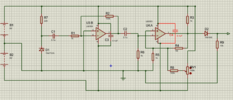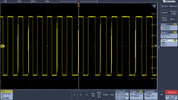undelivered
New Member
Hi, I am developing a project for Uni at an EEE student which has various stages but I'm struggling with the generation of a random stream of bits from noise which will feed into a shift register. I am attaching the schematic in the hope someone can make some suggestions.
The supply is +6V and -6V
The circuit uses a reverse biased zener 1N4733ATR to generate noise.
This is then amplified by an LM358 Op Amp which I was hoping for around -50mA to +50mA centred at 0.
This goes into a LM393 comparator with a pot to try and centre the output.
Finally I pass it through an IN4148 diode to so that I get either 6V (or 5+ V) or 0V output which goes into the CMOS shift register.
I don’t want to use an MCU.
I'm getting inconsistent results. It seems quite overly sensitive and gives different levels of noise. I'm also not convinced it is random and looking at the output from the op amp on the oscilloscope there may be some oscillation there though I tried to filter out any possible mains interference with RD filter after the amp.
Even if it was complete random I am seeing drift of the centre point and have to tweak the pot so I do get an equal share of 1's and 0's.
This is all quite new to me so please be quite specific about any feedback so I can understand clearly.
Thanks in advance.
The supply is +6V and -6V
The circuit uses a reverse biased zener 1N4733ATR to generate noise.
This is then amplified by an LM358 Op Amp which I was hoping for around -50mA to +50mA centred at 0.
This goes into a LM393 comparator with a pot to try and centre the output.
Finally I pass it through an IN4148 diode to so that I get either 6V (or 5+ V) or 0V output which goes into the CMOS shift register.
I don’t want to use an MCU.
I'm getting inconsistent results. It seems quite overly sensitive and gives different levels of noise. I'm also not convinced it is random and looking at the output from the op amp on the oscilloscope there may be some oscillation there though I tried to filter out any possible mains interference with RD filter after the amp.
Even if it was complete random I am seeing drift of the centre point and have to tweak the pot so I do get an equal share of 1's and 0's.
This is all quite new to me so please be quite specific about any feedback so I can understand clearly.
Thanks in advance.
Attachments
Last edited:




